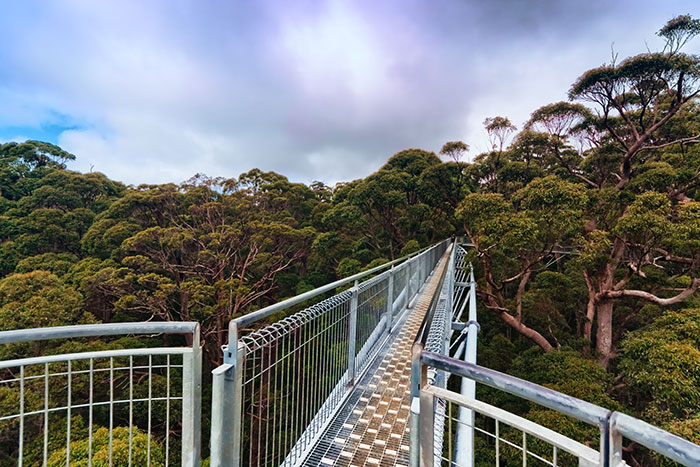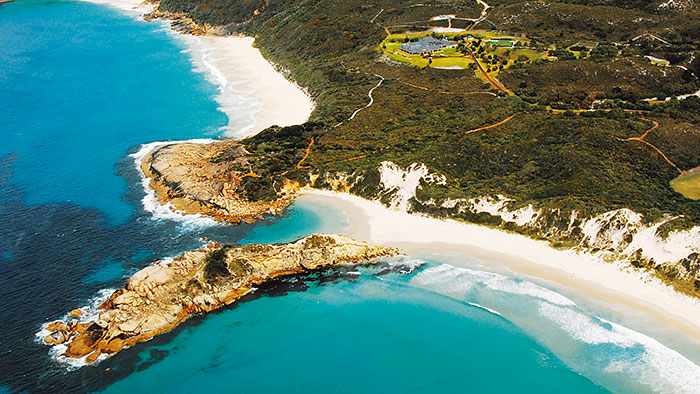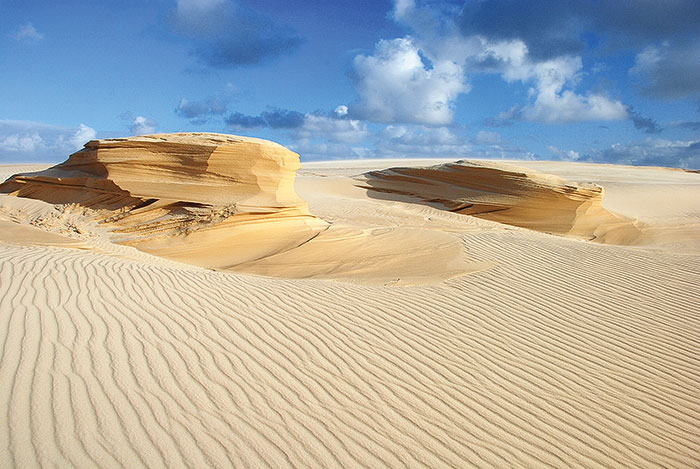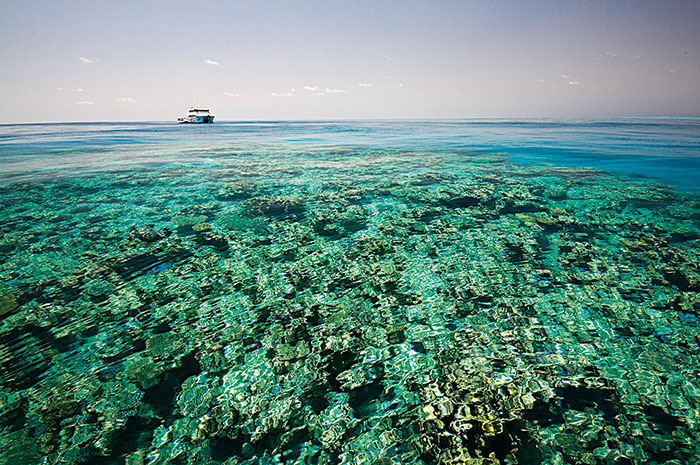The activities and experiences that should be right at the top of your to-do list.
From scuba diving beneath the Nullarbor to watching tonnes of water fly down Mitchell Falls, there's a seemingly unlimited number of things to do in Western Australia before you check out... These are at the very top of our list.
Langley Park Skydiving
What better way to view Perth's CBD and Swan River than by flying overhead and coming in to land right next door? Jump from 14,000ft and float down for 360-degree vistas across the city. If you're after a jump further afield, there are also opportunities to skydive in Jurien Bay, York, Busselton, Pinjarra and Mandurah.
Dampier Peninsula
One of the few places where you can enjoy an Indigenous experience with local communities that welcome tourists, the Dampier Peninsula has plenty of awesome places for an overnight stay, plus it's an easy side-trip after luxuriating in Broome.
Kalgoorlie Super Pit
Located on the famous Golden Mile, and surprisingly close to Kalgoorlie town centre, the Super Pit is the biggest open-pit gold mine in the country. Producing up to 850,000 ounces of gold every year, and with 750 personnel on site, its operation far outweighs any other mining centre in Australia.
As deep as Uluru is high and with about the same circumference, its public lookout is open 7am to 9pm daily. From there, you can take a look at this enormous mining operation in action. There are family-friendly tours, or you can take a scenic flight over the mine. Blasting occurs regularly, and while advance notice is given where possible, for the most up-to-date information contact Kalgoorlie Boulder Pure Gold on (08) 9021 1966.
Bibbulmun Track
One of the world's great long-distance 'walk-only' trails, the famous Bibbulmun Track stretches nearly 1000km from Kalamunda to historic Albany on the south coast. Enjoy a gentle stroll in the peace and beauty of the natural environment, or take on an epic eight-week adventure though towering karri and tingle forests, down mist-shrouded valleys, over giant granite boulders and along breathtaking coastal heathlands.
Ferguson Valley
The Ferguson Valley has an abundance of wineries and restaurants, not to mention the bizarre Gnomesville, home to thousands of gnomes placed in the open forest for all to enjoy – a spooky, wacky place to visit, especially at night. Limited boutique chalets and farmstays are available, but if you can't find anywhere, Bunbury is full of hotels and only 20 minutes away.

Valley of the Giants
Get ready to be inspired by the Valley of the Giants, where you'll find the majestic red tingle trees that populate part of the Walpole-Nornalup National Park. Growing up to 80m high, and with a circumference of up to 16m at the base, these enormous trees are a sight to see. Take a wander along the Tree Top Walk, a boardwalk up to 40m high that winds through the canopy.
Munda Biddi Trail
One of the longest mountain-bike trails in the world, the Munda Biddi extends 1000km between Mundaring and Albany (the final leg was completed in 2013). There are sections to suit all ages and fitness levels, from short day trips to weeklong adventures. Take adequate water and check for conditions and closures before departing.
Lena Dive Wreck
The Lena is the most accessible dive wreck in the state, sitting in just 18m of water, three nautical miles off Bunbury. It's a former Patagonian Toothfish vessel captured by the Australian navy for illegal fishing off Heard Island in the subantarctic, about 4000km south of Albany. Bunbury local ingenuity saw the pirate ship brought to town and sunk to use as a dive site. A tour is the best way to dive it, and it's suitable for both snorkelling and diving. Summer is a great time to visit because the water clarity is exceptional. For more diving in WA see For Lovers of Diving from page 86.
Gloucester Tree
Especially chosen as a fire lookout in 1947, this amazing tree was named after the then Governor-General of Australia, and climbing it is something of a test of bravery. We're yet to hear of someone getting injured, but that doesn't stop the 72m ascent being a truly daunting climb for anyone with a fear of heights. Once you're at the top, however, there's an unparalleled view across the glorious karri forest to enjoy.

Maitraya
Maitraya in the Great Southern is the most spectacular private retreat in the state. The enormous estate outside Albany is set on more than 500 acres (the main homestead alone boasts 6000 square metres of living space). You'll find family-friendly facilities such as a large theatre room, tennis court, cricket pitch, indoor heated pool and a fully enclosed children's play area, but the true gems are the secluded lagoon with sheltered waters just a short stroll from the retreat, and the patio with spectacular views overlooking the Southern Ocean. If you're keen for a day of pampering, services can be arranged to visit the retreat, including massages, pedicures, Pilates… you can even request a private chef. For more information click here.
Mitchell Falls
Majestic any time of year, these are best seen in the wet season, when the spectacular view of tonnes of water crashing into huge pools is simply unforgettable. You can camp and walk the 5km in, which takes a while but is worth it in the end. Those with a little pocket-cash can walk in then take a helicopter back over the falls to the camping ground.
Whale Sharks
Head to Coral Bay or Exmouth for this once-in-a-lifetime experience. The Ningaloo Reef is the only place in Australia where you can swim with an 18m shark – and you don't have to worry about getting eaten. Why? Whale sharks have a palate and jaw set-up designed for krill, not humans. See them between late March and early July – the spawning of coral occurs in March and April, and brings with it a diet fit for a whale shark.
Bungle Bungles Scenic Flight
The Bungle Bungle Range is best viewed from the air. Ride in a plane or take a helicopter over the World Heritage-listed Purnululu National Park, and a night camping in the Bungle Bungles should be a must on any trip to the Kimberley. Remember to check the weather before you go: if there is the slightest wind, you'll blow away among all the dust. Not camping? Pack a picnic, then watch the sun go down (or up) through the mounds.
-003.jpg)
Karijini National Park
The jewel of the Pilbara, Karijini is an adventure more than two billion years in the making. One of its big attractions is its accessibility: while 4WDs are recommended, it's possible to get away with a 2WD. Just pull into the car park, walk 50m and you'll be peering down into 100m gorges containing waterfalls and emerald-coloured rock pools. The fit and adventurous can take one of the many walk trails to explore the gorges further, while for those interested in abseiling and rock climbing there are several tours. You can even float down the gorges on a tyre-tube, if you so desire.
Avon Valley Hot-Air Balloon Ride
View the lush fields and undulating hills at dawn from the unusual perspective offered by a hot-air balloon. It's a spectacular and picture-perfect start to the day. Flights operate from April to November to avoid the hot and windy weather during summer.
West End of Rottnest
A summer holiday to beautiful Rotto – with its 63 beaches – is a regular for most Perthians, even just for a weekend stay. If you haven't ventured there before, shame on you! A trek to the West End is part of the holiday experience; it's about 11km from end to end. Bring your own bike, or hire one, otherwise you can walk (if you don't mind the distance).
Busselton Jetty Night Dive
One of the best dives in WA, this includes a mix of local fish suited to the local climate and tropical fish that come down via the Leeuwin current and then survive in the shallow (and therefore warmer) waters of Geographe Bay.
Swim with the Dolphins in Bunbury
Less than two hours' drive from Perth you can get up close and personal with wild bottlenose dolphins in Bunbury, either by taking an Eco Dolphin Cruise, or guided by a marine biologist at the Dolphin Discovery Centre on Koombana Bay.

Yeagarup Dunes
The Yeagarup Dunes in D'Entrecasteaux National Park formed 8000 years ago, and at 10km long this is the largest land-locked dune system in the Southern Hemisphere. The system is moving away from the ocean and towards the forest at a rate of four metres a year, and it's a fascinating place to visit. The dunes are tricky and not easy to navigate, however, so a good bet is to join a tour – it's the best way to 4WD the area, plus you'll get great insight into the dune system.
Snorkel the Ningaloo Reef
It's Australia's largest fringing reef, which means it's on par with the Great Barrier Reef (well, we think so!), plus it lies just metres from the shore, rather than out to sea. Tim Winton has loved this place for years, and the rest of the world is catching on. TIP: book safari tent accommodation for a great taste of the wilderness, but with a few creature comforts.
Kimberley Coastal Accommodation
There is a limited number of unique accommodation options on the Kimberley coast. Some are more rustic, some are just one step up from camping, and therefore in the range of a few hundreds dollars per night; others, meanwhile, are total luxury, and in the $1000 per person per night range. Whatever you choose, it is a chance to spend some quality time in one of the most isolated and unique environments in the world. We haven't heard a bad report about any of them. To view Kimberley accommodation click here.
Berkeley River
A night on the Berkley River is among the most unique, and also the most expensive, coastal accommodation options in the Kimberley. The floatplane from Kununurra is just the beginning of one unique experience after another. This is the place to be totally wowed.

Rowley Shoals
Want to see some of the world's most untouched coral gardens? The Rowley Shoals Marine Park is considered one of the world's most pristine diving areas. It's 12 hours by boat from Broome, in a prime game-fishing zone, and rises spectacularly from the edge of Australia's continental shelf where it experiences five-metre tides (meaning huge amounts of water rush in and out). At its widest and deepest point, it's been hailed as one of the best (read 'perfect') studies in geomorphology (the processes that shape landforms). Made up of three coral atolls – Mermaid, Clerke and Imperieuse reefs – it is home to more than 600 species of fish, including two-thirds of Australia's tropical population.
Swan Valley
There's so much to love about the Swan Valley. Besides being the second-closest wine region to any capital city in the world (it's only 25 minutes from Perth), it has a huge range of local produce to be sampled, from chocolates and fudge to cheese and beers. Don't forget to stop in at the visitor centre in Guildford on the way in – they've got great family-friendly itineraries ready to roll out to anyone that enquires. For things to do in the Swan Valley click here.
Esperance Beaches
People often claim that Esperance's beaches are the most pristine they've ever seen... and they'd be right. After careful scientific measurement, Lucky Bay was recognised by a national body as Australia's whitest beach; the sand is so fine it squeaks when you walk on it. You need to take in these beaches at least once in your lifetime, plus there's also great fishing, hiking, diving and camping to be had in the national parks and surrounds.
Gibb River Road
The Gibb River Road traverses 660km through the central Kimberley Plateau from King Sound at Derby to the Cambridge Gulf at Wyndham, and takes in waterfalls, gorges, wildlife and adventure. The majority of the road surface is of dirt and gravel construction, with only some floodways paved. High-clearance, robust 4WD vehicles are recommended for dry season (May to October) travel, while travel in the wet season (November to April) can be severely restricted by flooding and road closures.
Abrolhos Islands
The wonderfully diverse Abrolhos Islands are rich in marine fauna and other wildlife, and host a thriving fishing and crayfishing community. The 122 islands are divided into three groups – Wallabi, Easter and Pelsaert – and are spread across 100km of ocean, with the most commonly known ones about 60km west of Geraldton. The islands and their surrounding reef communities are a meeting place for tropical and temperate sea life, making it a fisher's paradise, while history buffs can tread the same ground as some of the first European visitors to our shores on these islands. There are many historic shipwreck tales to investigate here – the most famous, perhaps, being the wild tale of human savagery that befell those on the Dutch ship Batavia.

Bluff Knoll
Southern WA's highest peak is in the Stirling Ranges and attracts a number of hikers each year, keen to test their fitness skills. At 1095m high, the mountain cops a dusting of snow every now and then. Regular climbers aim for a PB every time they surge up it.
Dive Cocklebiddy Cave
Even if you've dived all over the world, there's no more exciting (or potentially terrifying) descent than swimmimg through Cocklebiddy Cave, 90m below the Nullarbor. Located east of Norseman, the cave entrance is more than 300m long and leads to a 180m-long lake – it's actually been rated above the Great Barrier Reef in Lonely Planet's top scuba spots. A dive through the cave carries serious risk, however – you'll need to be an advanced diver, be part of a cave diving club, and have a permit to dive the cave. Highlights include the underground lake Toad Hall, but this dive is mostly about the water's eerie visibility levels: it's so clear, it's been said that you can't even tell you're underwater.